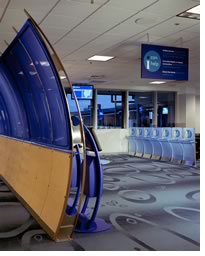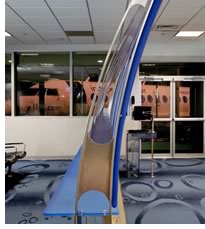

06/2005
Low-cost airline inspires high-impact budget-conscious design
 Optimism surrounded
the launch of Independence Air’s service from Dulles Airport, and
that hopefulness extended to design plans for the airline’s new
Virginia hub. But, soon enough, amid financial turbulence, officials
at the low-cost airline thought they had to do away with elaborate plans
for their new terminal. DMJM’s project team assured them that they
could rethink the project to get the exciting and brand-conscious scheme
they all envisioned.
Optimism surrounded
the launch of Independence Air’s service from Dulles Airport, and
that hopefulness extended to design plans for the airline’s new
Virginia hub. But, soon enough, amid financial turbulence, officials
at the low-cost airline thought they had to do away with elaborate plans
for their new terminal. DMJM’s project team assured them that they
could rethink the project to get the exciting and brand-conscious scheme
they all envisioned.
With budget concerns at the forefront, airline officials thought they were going to have to settle for a new carpet and a paint job to spruce up their interior arrivals and departures area. But Shub Sanyal, DMJM project designer in the firm’s Washington, D.C., office, says the team, which also included Austin (formerly McClier), focused on making design changes that would get maximum impact. One of the issues they examined was the flow of passengers and the bottlenecks that create stressful spaces for travelers at airport gates.
 “We
took a new approach to airline concourse circulation,” Sanyal
says. The 43,000-square-foot public concourse is arranged into three
holding rooms serving the entire terminal. Passengers flow from the holding
rooms into smaller corridors that feed each arrival and departure gate.
Each corridor has up to six gates that service the regional jets. Deplaning
passengers exit through a curved passageway mimicking a plane fuselage,
and each customer service desk gently curves in keeping with the circular
theme of the airline’s brand identity. The result is that departing
passengers and arriving travelers go through separate gates.
“We
took a new approach to airline concourse circulation,” Sanyal
says. The 43,000-square-foot public concourse is arranged into three
holding rooms serving the entire terminal. Passengers flow from the holding
rooms into smaller corridors that feed each arrival and departure gate.
Each corridor has up to six gates that service the regional jets. Deplaning
passengers exit through a curved passageway mimicking a plane fuselage,
and each customer service desk gently curves in keeping with the circular
theme of the airline’s brand identity. The result is that departing
passengers and arriving travelers go through separate gates.
Enhancing the “brand”
 The
designers looked at how they could enhance the energetic, people-oriented
brand that the airline already had created. The design of the terminal
furthers brand recognition by incorporating Independence Air’s
logo in both the architectural elements and the distinctive fixtures,
DMJM architects note. The designers took advantage of Independence
Air’s strong color palette with its brilliant blue and white
hues and fin-shaped detailing. That fin silhouette follows through
to customer-service elements, including the courtesy phones, poles
for plasma screens with flight information displays, and 10 Internet
stations located at each gate for easy customer identification. For
the Web stations, the designers made them café style, as they
noted that Independence Air catered to many business travelers
who did not spend much time waiting at the gate, but who would plug
in their laptops at kiosk stands to do some quick work or check their
e-mail.
The
designers looked at how they could enhance the energetic, people-oriented
brand that the airline already had created. The design of the terminal
furthers brand recognition by incorporating Independence Air’s
logo in both the architectural elements and the distinctive fixtures,
DMJM architects note. The designers took advantage of Independence
Air’s strong color palette with its brilliant blue and white
hues and fin-shaped detailing. That fin silhouette follows through
to customer-service elements, including the courtesy phones, poles
for plasma screens with flight information displays, and 10 Internet
stations located at each gate for easy customer identification. For
the Web stations, the designers made them café style, as they
noted that Independence Air catered to many business travelers
who did not spend much time waiting at the gate, but who would plug
in their laptops at kiosk stands to do some quick work or check their
e-mail.
For inspiration, the designers, who also included Ray Rarick, AIA, of Austin, looked to the ways new hub terminals for Southwest Airlines and Jet Blue were rolled out. Ultimately, in keeping with the airline’s “low cost, high impact” philosophy, the project was completed in about three months for $11 million.
Copyright 2005 The American Institute of Architects.
All rights reserved. Home Page ![]()
![]()
 |
||
Photos © Anice Hoachlander/Hoachlander Davis Photography.
|
||